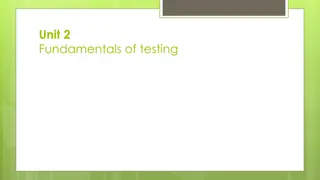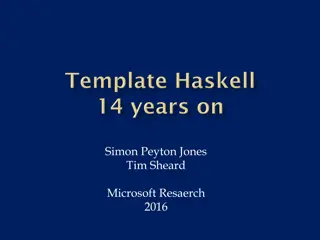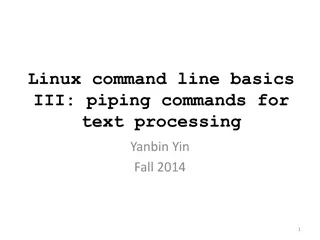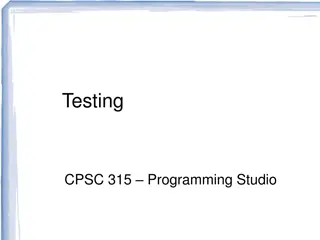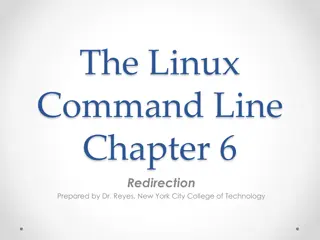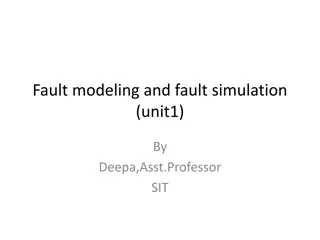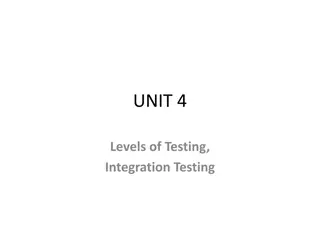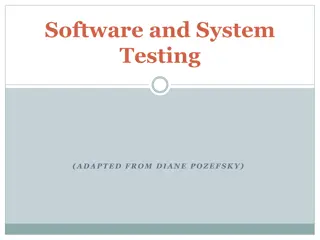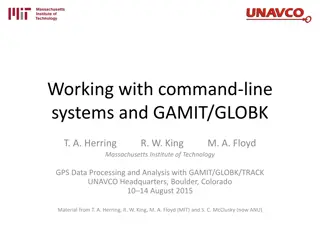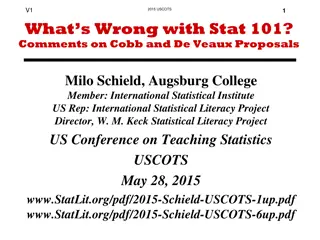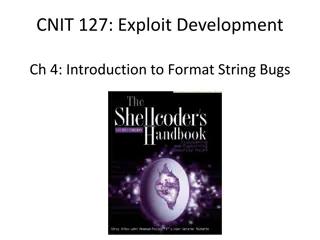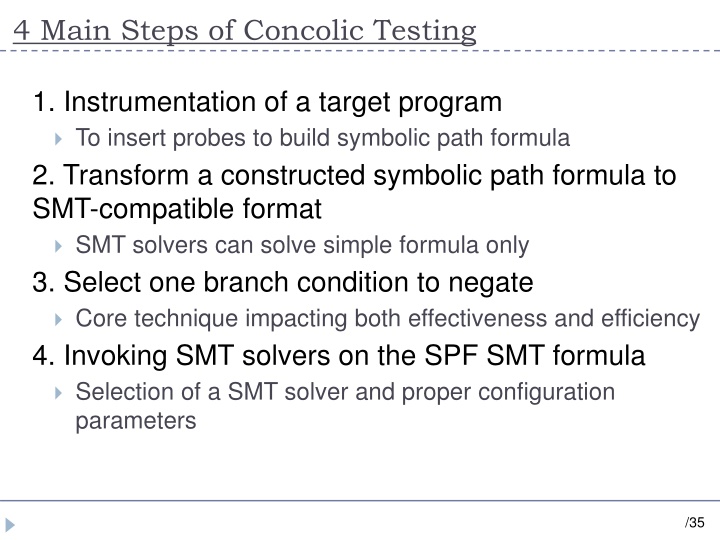
Concolic Testing Steps and Tasks Overview
Learn about the main steps and tasks involved in concolic testing, including instrumentation of target programs, selection of symbolic variables, and performance tuning. Explore how human engineers contribute to the success of concolic testing. Dive into a detailed overview of testing Busybox using different strategies and experimental environments.
Download Presentation

Please find below an Image/Link to download the presentation.
The content on the website is provided AS IS for your information and personal use only. It may not be sold, licensed, or shared on other websites without obtaining consent from the author. If you encounter any issues during the download, it is possible that the publisher has removed the file from their server.
You are allowed to download the files provided on this website for personal or commercial use, subject to the condition that they are used lawfully. All files are the property of their respective owners.
The content on the website is provided AS IS for your information and personal use only. It may not be sold, licensed, or shared on other websites without obtaining consent from the author.
E N D
Presentation Transcript
4 Main Steps of Concolic Testing 1. Instrumentation of a target program To insert probes to build symbolic path formula 2. Transform a constructed symbolic path formula to SMT-compatible format SMT solvers can solve simple formula only 3. Select one branch condition to negate Core technique impacting both effectiveness and efficiency 4. Invoking SMT solvers on the SPF SMT formula Selection of a SMT solver and proper configuration parameters /35
4 Main Tasks of Human Engineers 1. Adding proper assert() statements W/o assert(), no test results obtained 2. Selection of symbolic variables in a target program Identify which parts of a target program are most important 3. Construction of symbolic external environment To detect real bugs 4. Performance tuning and debugging To obtain better concolic testing results /35
Busybox Overview We test a busybox by using CROWN. BusyBox is a one-in-all command-line utilities providing a fairly complete programming/debugging environment It combines tiny versions of ~300 UNIX utilities into a single small executable program suite. Among those 300 utilities, we focused to test the following 10 utilities grep, vi, cut, expr, od , printf, tr, cp, ls, mv. We selected these 10 utilities, because their behavior is easy to understand so that it is clear what variables should be declared as symbolic 3 /35 4/12/2025
Experiment overview Experimental environments HW: Core(TM)2 E8400@3GHz, 4GB memory OS: fc8 32bit Target program: busybox 1.17.0 Strategies: 4 different strategies are used in our experiment. dfs: explore path space by (reverse) Depth-First Search cfg: explore path space by Control-Flow Directed Search random: explore path space by Random Branch Search random_input: testing target program by randomly generating input In addition, a port-polio approach is applied (i.e., merging the test cases generated by all four above strategies). 4 /35 4/12/2025
Target description -- printf Description: controls the output exactly as in C printf. print ARGUMENT(s) according to FORMAT, where FORMAT Usage: printf FORMAT [ARGUMENT]... Example : input: ./busybox printf %s is coming' 'autumn output: autumn is coming 5 /35 4/12/2025
Target program setting -- printf Experiment Setting : Target utilities: busybox printf Usage: printf FORMAT [ARGUMENT]... Symbolic variables setting: 1. Set FORMAT as symbolic value. Type of FORMAT is string. Restrict 5 symbolic characters as input of FORMAT. 2. Set ARGUMENT as symbolic value. Type of ARGUMENT is array of string. Restrict ARGUMENT to 1 length, 10 symbolic characters for each string. 3. Replace library function by source code: strchr(). We perform experiments in the following approach: 1. run experiment by various strategies. 6 /35 4/12/2025
Result -- printf Experiment setting: Iterations: 10,000 branches in printf.c : 144 Execution command: run_crown './busybox printf '%d123' 0123456789' 10000 -dfs run_crown './busybox printf '%d123' 0123456789' 10000 -cfg run_crown './busybox printf '%d123' 0123456789' 10000 -random run_crown './busybox printf '%d123' 0123456789' 10000 -random_input Command-line arguements are just place holders (i.e., their content will be replaced by symbolic values) Strategy Time cost (s) 84 41 40 30 Dfs Cfg Random Pure_random 7 /35 4/12/2025
Symbolic setup in source code for printf Two main instruments in busybox printf.c. Set 2 symbolic inputs:FORMAT, ARGUMENT. Replace library function strchr() by source code. 1. 2. 3. 4. 5. 6. 7. 8. 9. 10. #endif 11. // 12. } 13. // 14. int printf_main(int argc UNUSED_PARAM, char **argv) 15. { 16. int conv_err; 17. char *format; 18. char **argv2; 19. // 20. format = argv[1]; 21. argv2 = argv + 2; 22. int i; 23. int argcc=strlen(format); 24. #ifdef CROWN 25. for( i=0 ; i<argcc ; i++){// argcc = 5 due to the fixed input static void print_direc(char *format, unsigned fmt_length, int field_width, int precision, const char *argument) { // #ifndef CROWN have_width = strchr(format, '*'); #else have_width = sym_strchr(format, '*'); 26. SYM_char(format[i]); 27. } 28. for(i= 0 ; i<10 ; i++){ 29. SYM_char(argv2[0][i]); 30. } 31. #endif 32. // 33. } 34. static char *sym_strchr(const char *str, char ch){ 35. while (*str && *str != ch) 36. str++; 37. if (*str == ch) 38. return str; 39. return(NULL); 40. } 8 /35 4/12/2025
Target description -- grep Options: -H Add 'filename:' prefix -h Do not add 'filename:' prefix -n Add 'line_no:' prefix -l Show only names of files that match -L Show only names of files that don't match -c Show only count of matching lines -o Show only the matching part of line -q Quiet. Return 0 if PATTERN is found, 1 otherwise -v Select non-matching lines -s Suppress open and read errors -r Recurse -i Ignore case -w Match whole words only -F PATTERN is a literal (not regexp) -E PATTERN is an extended regexp -m N Match up to N times per file -A N Print N lines of trailing context -B N Print N lines of leading context -C N Same as '-A N -B N' -f FILE Read pattern from file Description: FILEs (or stdin). Search for PATTERN in Usage:grep [OPTIONS] PATTERN [FILE] OPTIONS includes [-1nqvscFiHhf:Lorm:wA:B:C:EaI] (option followed by : means one argument is required.) Example : test_grep.dat contains define enifed what is defined? input: busybox grep define test_grep.dat output: define def ine what is defined? 9 /35 4/12/2025
Symbolic Variable Declaration for grep PATTERN was not declared as symbolic variables, since grep.c handles PATTERN using external binary libraries CROWN would not generate new test cases for symbolic PATTERN We used a concrete pattern define We use a concrete file test_grep.dat as a FILE parameter Set options as symbolic input (i.e. an array of symbolic characters) 23 different options can be given. Specified options are represented by option_mask32, an uint32_t value, of which each bit field indicates a corresponding option is ON/OFF. Function getopt32(char **argv, const char *applet_opts, ) is used to generate a bit array option_mask32 which indicates specified options from command line input. Set 4 parameters to options as symbolic variables Copt, max_matches, lines_before, lines_after. Option argument fopt for option -f (read a pattern from a file) is ignored, since it is hard to set a file name as a symbolic value. 10 /35 4/12/2025
Instrumentation in grep.c 1. 2.uint32_t option_mask32; 3.... 4.int grep_main (int argc UNUSED_PARAM, char **argv) 5.{ 6. getopt32(argv, OPTSTR_GREP, 7. &pattern_head, &fopt, 8. &max_matches, &lines_after, 9. &lines_before,&Copt); 10. #ifdef CROWN 11. SYM_int(max_matches); 12. SYM_int(lines_after); 13. SYM_int(lines_before); 14. SYM_int(Copt); 15. 16. #endif 17. // 18. #ifdef CROWN 19. SYM_int(option_mask32); 20. #endif 21. if (option_mask32 & OPT_m) { 11 /35 4/12/2025
Result of Busybox grep Experiment 1: Iterations: 10, 000 branches in grep.c : 178 Execution Command: run_crown './busybox grep "define" test_grep.dat' 10000 -dfs run_crown './busybox grep "define" test_grep.dat' 10000 -cfg run_crown './busybox grep "define" test_grep.dat' 10000 -random run_crown './busybox grep "define" test_grep.dat' 10000 -random_input Strategy Dfs Cfg Random Pure_random Time cost (s) 2758 56 85 45 12 /35 4/12/2025
Test Oracles In the busybox testing, we do not use any explicit test oracles Test oracle is an orthogonal issue to test case generation However, still violation of runtime conformance (i.e., no segmentation fault, no divide-by-zero, etc) can be checked Segmentation fault due to integer overflow detected at grep 2.0 This bug was detected by test cases generated using DFS The bug causes segmentation fault when -B 1073741824 (i.e. 2^32/4) PATTERN should match line(s) after the 1st line Text file should contain at least two lines Bug scenario Grep tries to dynamically allocate memory for buffering matched lines (-B option). But due to integer overflow (# of line to buffer * sizeof(pointer)), memory is allocated in much less amount Finally grep finally accesses illegal memory area 13 /35 4/12/2025
Bug patch was immediately made in 1 day, since this bug is critical one Importance: P5 major major loss of function Busybox 1.18.x will have fix for this bug 14 /35 4/12/2025
Target description -- vi Description: Edit FILE Usage: vi [OPTIONS] [FILE] Options: -c Initial command to run ($EXINIT also available) -R Read-only -H Short help regarding available features Example : input: cat read_vi.dat test for initial command input: cat test_vi.dat this is the test for vi @#$%&*vi? input: ./busybox vi -c ":read read_vi.dat" test_vi.dat output: this is the test for vi test for initial command @#$%&*vi? 15 /35 4/12/2025
Symbolic Variable Declaration for vi We declared a key stroke by a user as a symbolic input character Restrict user key input to 50 symbolic characters. We modified vi source code so that vi exits after testing 50th key stroke. Set initial command as symbolic input (initial command is only used when option -c is specified). Type of initial command is a string (i.e., an array of 17 characters) Replace 4 library functions with source code: strncmp(), strchr(), strcpy(), memchr(). We used a concrete file test_vi.dat 16 /35 4/12/2025
Symbolic Key-stroke Setting 1.static int readit(void){ 2. // 3. #ifndef CROWN 4. c = read_key(STDIN_FILENO, readbuffer, -2); 5. #else 6. if(count<50){ 7. char ch; 8. SYM_char(ch); 9. putc(ch, finput); 10. c=(int)ch; 11. count++; 12. }else { 13. fclose(finput); 14. exit(0); 15. } 16. #endif 17. // 18.} 17 /35 4/12/2025
4 Functions Added 1. static int sym_strncmp (const char *first,const char *last,int count) 2. { 3. if (!count) 4. return(0); 5. 6. while (--count && *first && *first == *last){ 7. first++; 8. last++; 9. } 10. return( *(unsigned char *)first - *(unsigned char *)last ); 11.} 12. 13.static char *sym_strchr(const char *str, char ch){ 14. 15. while (*str && *str != ch) 16. str++; 17. 18. if (*str == ch) 19. return str; 20. 21. return(NULL); 22. 23.} 24. 25.static char *sym_strcpy(char *to, const char *from) 26.{ 27. char *save = to; 28. for (; (*to = *from) != '\0'; ++from, ++to); 29. return(save); 30.} 31. 32.void *sym_memchr(const void* src, int c, size_t count) 33.{ 34. assert(src!=NULL); 35. char *tempsrc=(char*)src; 36. while(count&&*tempsrc!=(char)c) 37. { 38. count--; 39. tempsrc++; 40. } 41. if(count!=0) 42. return tempsrc; 43. else 44. return NULL; 45.} 18 /35 4/12/2025
Result of vi Experiment 1: Iterations: 10,000 Branches in vi.c : 1498 Execution Command: run_crown './busybox -c ":read read_vi.dat" test_vi.dat' 10000 -dfs run_crown './busybox -c ":read read_vi.dat" test_vi.dat' 10000 -cfg run_crown './busybox -c ":read read_vi.dat" test_vi.dat' 10000 -random run_crown './busybox -c ":read read_vi.dat" test_vi.dat' 10000 -random_input Strategy Time cost (s) 1495 1306 723 463 Dfs Cfg Random Pure_random 19 /35 4/12/2025


